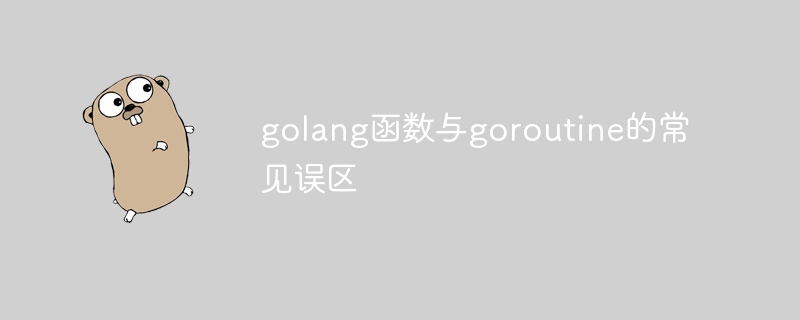Home >Backend Development >Golang >Common misunderstandings between golang functions and goroutine
Common misunderstandings between golang functions and goroutine
- WBOYWBOYWBOYWBOYWBOYWBOYWBOYWBOYWBOYWBOYWBOYWBOYWBOriginal
- 2024-04-25 10:36:011071browse
Common Go language functions and Goroutine misunderstandings: concurrent access to shared variables: avoid modifying shared variables in Goroutine, and use mutex locks or read-write locks to ensure safe access. Unclosed Channel: Close the Channel promptly after use to prevent the Goroutine from being permanently blocked. Ignore Goroutine errors: Use the Recover function to catch Goroutine panics and handle errors gracefully. Excessive use of Goroutines: Create Goroutines carefully according to needs to avoid resource exhaustion. Unsynchronized map usage: Use the sync.Map type to ensure data safety during concurrent access.

Common misunderstandings about Go language functions and Goroutines
Functions and Goroutines in the Go language are the cornerstones of concurrent programming. While they offer powerful functionality, they are prone to some common pitfalls if not used with care.
Trap 1: Do not modify shared variables in Goroutine
When Goroutine concurrently accesses shared variables, data competition may occur. In order to avoid this situation, synchronization mechanisms such as mutex locks and read-write locks can be used to ensure the security of concurrent access.
Example: Using a mutex to protect a shared counter
import (
"sync"
)
var count = 0
var mutex sync.Mutex
func incrementCounter() {
mutex.Lock()
defer mutex.Unlock()
count++
}Trap 2: Do not use an unclosed Channel
Un A closed Channel may cause the Goroutine to block forever on Read or Write operations. It is important to ensure that the Channel is properly closed after communication is complete.
Example: Properly close Channel
chan := make(chan int)
go func() {
for i := 0; i < 10; i++ {
chan <- i
}
close(chan) // 关闭 Channel
}()Trap 3: Don’t ignore Goroutine errors
Errors that occur in Goroutine if Not handled, may cause application instability. Use the Recover function to capture panics in Goroutines and handle errors correctly.
Example: Catching Goroutine panics
func main() {
go func() {
defer func() {
if p := recover(); p != nil {
// 处理恐慌
}
}()
// 可能会发生恐慌的代码
}()
}Trap 4: Don’t overuse Goroutines
Although Goroutines can improve concurrency, But too many Goroutines may exhaust system resources. Create Goroutines carefully based on the actual needs of your application to avoid unnecessary overhead.
Trap 5: Don’t use unsynchronized maps
Unsynchronized maps may cause data races during concurrent access. Use the sync.Map type to ensure concurrency safety.
Example: Using sync.Map to implement a thread-safe map
import "sync"
var myMap = sync.Map{}
func main() {
go func() {
myMap.Store("key", "value1")
}()
go func() {
if value, ok := myMap.Load("key"); ok {
fmt.Println(value) // 安全地读取 map 值
}
}()
}The above is the detailed content of Common misunderstandings between golang functions and goroutine. For more information, please follow other related articles on the PHP Chinese website!
Related articles
See more- Detailed explanation of comparative examples of ThreadLocal local threads and synchronization mechanisms in Java
- How to set time in golang
- How to determine whether map is empty in golang
- How to determine whether a golang structure is empty
- Decrypting the Go language synchronization mechanism: a powerful tool for concurrent programming

